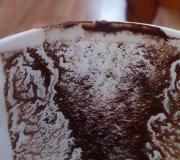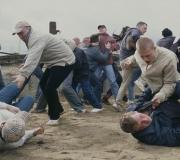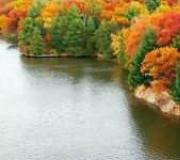Ferdinand Victor Eugene Delacroix biography. The most famous paintings
The artist Eugene Delacroix, whose paintings are exhibited in many museums in France and the world, is a representative romantic school. His canvases depict emotional moments from the life of humanity in different eras. In the mid-20s of the 19th century, the author became interested in the plots of the revolution. One of these paintings made him famous throughout the world.
Biography of the artist
Eugene Delacroix was born on April 26, 1798 into a poor family. His father was an official, minister of the Batavian Republic. In 1802, he was transferred to a position in Bordeaux, where the whole family followed him. He spent little time with his son, since he died when Eugene was about 7 years old. After the death of the head of the family future artist with his mother and other children he moves to Paris, where he enters the Lyceum. IN educational institution the boy studies literature, music, and also gets acquainted with the basics of drawing.
The year Eugene turned 16, his mother dies, and he finds himself in the poor family of his relatives. A year later the guy enters art school, where he studies various areas of creativity and meets famous creators. At the end of his studies, Delacroix decided to go to England for a while to get acquainted with the masterpieces visual arts and literature of this country. Eugene Delacroix was so inspired by the works of the masters that lighter and lighter colors appeared in his canvases.
All his life, Eugene Delacroix, whose paintings were and remain a treasure and pride, created for his people. He was constantly in the process of studying and improving his technique. He studied with old masters, constantly traveled and studied new painting techniques.
Eugene Delacroix, whose biography is filled with travel and creative processes, died in Paris from an illness he had been battling long time. The tragedy occurred in 1863, when the artist turned 65 years old.
Paintings

After traveling to England, the artist, impressed by the work of William Shakespeare, painted several canvases related to the talented writer himself and his creations. Thus, the paintings “The Death of Ophelia”, “Hamlet” and many others were born.
After traveling to Morocco, the artist created many paintings related to the peculiarities of the life and way of life of the African people. He was impressed by the exoticism, color and traditions of this country.
Delacroix also visited Spain and Algeria, which introduced additional notes, tones and colors into his work, fundamentally changing his painting style. During the journey the artist creates a large number of watercolor works, sketches and sketches, which later served Starting point to create such works as “Wedding in Morocco”, “Algerian Women”, “Tiger Hunt” and others.
Eugene Delacroix, whose paintings mainly depicted subjects modern world, also began to contact historical events. Inspired by the stories of battles, the artist creates canvases “The Battle of Thaiburg”, “The Battle of Poitiers” and others.
The most famous paintings
One of the most famous paintings by Eugene Delacroix is a painting painted in 1830 under the name “Freedom on the Barricades”. She talks about events french revolution, which occurred in July of the same year. The painting was first exhibited in the spring of 1831 in Paris.

The painting instantly gained popularity, but it was not bought by a wealthy collector, but by the state, and was not exhibited for about a quarter of a century. The reason for this is its revolutionary plot. The author invested in his brainchild faith in his people, who are marching for Freedom. She is shown on the canvas as a girl with a French flag in her hand, boldly walking forward.
The artist is the author of frescoes in the churches of Saint-Dulis and Saint-Sulpice. Also, Eugene Delacroix, whose works became popular in the country along with his name, was invited to paint the throne room and library of the Chamber of Deputies.

Comprehensively developed person was Eugene Delacroix. Paintings were not his whole life. At the age of 53, he was elected to the Paris city council, and a few years later he was awarded the Order of the Legion of Honor. At the same time, he presented a number of his works at the world exhibition.
Eugene Delacroix, whose biography in short form presented in the article, conveyed on canvas all the emotions and feelings that overwhelmed him.
Delacroix made history French painting How chief representative a new romantic movement, which, from the mid-twenties of the nineteenth century, opposed itself to official academic art.
Enriching the art of painting with new means artistic expression, Delacroix rejected the frozen linear structures of “classical” compositions, returning color to its primacy, introducing bold dynamics and breadth of execution into his canvases, directly expressing intense inner life his heroes.
Baudelaire, in his poem “Beacons,” wrote that “Delacroix is a lake of blood, shaded by a forest of pines, ever green, where strange sounds of fanfares like Webor pass under the gloomy sky.” And this is how he deciphers this image: “The lake of blood is the red color of his paintings, the forest of pine trees is green color, complementary to the red, the gloomy sky is the stormy background of his paintings, Vebor's fanfare is the thoughts of romantic music that are excited by the harmony of his coloring.
Title: Self-portrait in Hamlet costume.
Date: 1821
Material: Canvas, oil.
Ferdinand Victor Eugene Delacroix was born on April 26, 1798 in Charenton, two miles from Paris. He was the fourth child of Victoria Delacroix, née Eben, from her marriage to Charles Delacroix, diplomat and minister plenipotentiary in the Batavian Republic. There he was at the time of the birth of his son. After returning to France, Charles Delacroix was first appointed prefect of Marseille, and then prefect of the Gironde, and he settled in Bordeaux. The whole family moved there in 1802.
In 1805, his father died, and Eugene went with his mother to Paris, where the boy was sent to the Paris Lyceum of Louis the Great. During his student years, he became interested in literature, music, and received his first drawing lessons. After graduating from the Lyceum in 1815, Eugene began studying with the portrait painter Henri François Riseneur. A year later, Riseneur introduced Eugene to his friend Guerin, and Delacroix became his student. However, staying in the workshop of a classicist - an adherent of the old academic canons - does not satisfy Eugene. He systematically visits the Louvre, studies the works of Rubens, Velazquez, Titian, and Veronese. Further big influence The young artist is influenced by the work of his classmate Gericault.

Title: Dante and Virgil in Hell.
Date: 1822
Painting size: 189x242 cm.
Material: Canvas, oil.
Museum: Paris. Louvre.
Independent professional activity Delacroix begins in his twenties. Exhibited in 1822 at the Louvre at the annual Salon exhibition, the painting “Dante and Virgil” gave the impression of “a meteorite falling into a stagnant swamp,” captivating with the passionate pathos of its images.

Title: Massacre on Chios.
Date: 1824
Painting size: 419x354 cm.
Material: Canvas, oil.
Museum: Paris. Louvre.
“The Massacre at Chios,” exhibited at the Salon of 1824, is the second big job artist, who promoted him and gave him the position of head of the young romantic school. The theme of human distress, human suffering runs through all of Delacroix’s work and is, as it were, its main leitmotif. When creating “The Massacre on Chios,” Delacroix felt that his feelings, his indignation were shared by thousands and tens of thousands of contemporaries from all walks of life. This helped him create a work of great social significance.

Name: Greece
on the ruins of Missolonghi.
Date: 1827
Painting size: 208x147 cm.
Material: Canvas, oil.
Museum: Bordeaux. Museum fine arts.
“The Massacre on Chios” provoked sharp criticism from adherents of classicism, but the young people accepted it with delight, seeing in Delacroix a discoverer of new paths in art. The artist painted another painting dedicated to the Greek struggle for national independence - “Greece on the ruins of Missolunga” (1827).

Title: Death of Sardanapalus.
Date: 1827
Painting size: 392x496 cm.
Material: Canvas, oil.
Museum: Paris. Louvre.
At the beginning of 1825, Delacroix went to London, where he studied the works of Gainsborough and Turner. In the theater he was shocked by Shakespeare, and throughout his life he turned to the works of the great playwright: “Hamlet” (1839), “The Death of Ophelia” (1844), “Desdemona Cursed by Her Father” (1852).
Under the influence of Byron, the artist creates paintings based on the themes of his works - “Tasso in the Lunatic Asylum” (1825), “The Execution of Doge Marine Falieri” (1826), “The Death of Sardanapalus”. (1827th).
After returning from London, the artist’s palette became noticeably lighter, probably under the influence of the paintings of John Constable. The Salon of 1827 turned out to be especially important for the artist: he exhibited 12 paintings there, which earned Delacroix, against his will, the reputation of the head of the romantic school. Among them was “The Death of Sardanapalus”.
“Success or failure - it will be my fault... it seems that I will be booed,” Delacroix wrote on the day when the public was supposed to see his masterpiece. And, indeed, he will never experience such a deafening failure. Among the many critical reviews, only Hugo, and even then in private correspondence, supported the artist: “Sardanapalus by Delacroix is a magnificent thing and so gigantic that it is inaccessible to scanty vision.”

Title: Freedom on the barricades.
(Freedom leading the people)
Date: 1830
Painting size: 360x225 cm.
Material: Canvas, oil.
Museum: Paris. Louvre.
After the revolution of 1830, the artist creates his own famous painting“Freedom on the Barricades,” 1831, is the brightest work of revolutionary romanticism, in which one can hear a bold and open call for an uprising and confidence in its inevitable victory.
“This painting provides a brilliant example of what Romanticism can create, and at the same time makes clear what it cannot. He turns to the real, he makes his plot a scene that took place before the eyes of his contemporaries, but immediately transforms it into an abstract plan, giving it the features of an allegory. He is fascinated by bright human characters, but he gives them symbolic roles in which their living personal traits cannot fully manifest themselves. And finally, being unable to reconcile the colors real world and his own pictorial system, conventional for all its expressiveness, he involuntarily turns to the arsenal visual arts, created by his eternal enemy - classicism. Nowhere else does romanticism strive with such force to expand the sphere of its usual thoughts, images and techniques and creates a work that deservedly received the honorary name “Marseillaise of French Painting,” writes art critic Kozhina.

Title: Algerian women.
Date: 1834
Painting size: 180x229 cm.
Material: Canvas, oil.
Museum: Paris. Louvre.
In 1832, Delacroix made a trip to Morocco, Algeria and Spain, which was crucial for the evolution of his work. Preserved in numerous drawings and watercolors vivid impressions, which he learned from his visit to the countries of the East. These impressions were expressed in paintings based on travel sketches: including “Wedding in Morocco” (1839-1841), “Sultan of Morocco” (1845), “Tiger Hunt” (1854- th), “The Lion Hunt” (1861) and the famous “Algerian Women” (1833-1834).
Painted in broad, bold strokes, Algerian Women is a veritable feast of color. When Edouard Manet wrote Olympia, he recalled one of the figures from Algerian Women. Signac, in the Neo-Impressionist manifesto, will take "The Women of Algeria" as the main example to demonstrate further evolution French art. And Paul Cézanne directly stated: “We all came out of this Delacroix.”

Title: Capture of Constantinople
Crusaders.
Date: 1840
Painting size: 81x99 cm.
Material: Canvas, oil.
Museum: Paris. Louvre.
Like all romantics, Delacroix shunned everything everyday and ordinary. He was attracted by great passions, exploits, and struggle. The tragic collision of man with the elements remained throughout his life one of the most exciting themes for the artist. These are his paintings on mythological, religious, historical topics- “The Battle of Poitiers” (1830), “The Battle of Nancy” (1831), “The Capture of Constantinople by the Crusaders” (1841).

Title: Portrait of Frederic Chopin.
Date: 1838
Painting size: 46x38 cm.
Material: Canvas, oil.
Museum: Paris. Louvre.
The artist's multifaceted talent manifested itself in various genres: he was, in particular, an excellent portrait painter. Delacroix was especially attracted to creative people. He painted portraits of Paganini (1831), Chopin (1838), George Sand, Berlioz, and a wonderful self-portrait in 1832.

Title: Self-portrait.
Date: 1860
Painting size: 65x55 cm.
Material: Canvas, oil.
Museum: Paris. Louvre.
Delacroix was a master of still life, landscape, and painted interiors and animals. He is one of the last great masters wall painting. Thus, Delacroix created three monumental ensembles: the central ceiling in the Apollo Gallery in the Louvre (1850), the Peace Hall in the Paris City Hall, two grandiose compositions in the Church of Saint Sulpice (1861) - “The Expulsion of Heliodorus from the Temple” and “The Battle of Jacob” with an angel."
After traveling through Morocco and Algeria, Delacroix lived and worked almost continuously in the capital. The only exception is a short trip to Belgium in 1850. The artist worked with full effort until the end of his life. Delacroix died on August 13, 1863.
Delacroix's artistic heritage is enormous. Its beautiful literary works on issues of history, art, “Diary”, which the artist kept from 1822 to 1863.
The last entry in it reads: “The first advantage of the picture is to be a feast for the eye...”. Delacroix's paintings fully justified this thesis, becoming a genuine event in the history of world art.
Famous French artist Eugene Delacroix (1798–1863), whose work is admired throughout the world, was a completely extraordinary person. Even its origin is still controversial. Officially, Eugene's father is considered to be the not very high-ranking official Charles Delacroix, although according to contemporaries, he only gave his name to the boy. The real father was the all-powerful minister and diplomat Charles Talleyrand. It is difficult to say whether this somehow affected Delacroix’s fate, but his biography cannot be called boring.
"Fire, water and copper pipes"
According to the recollections of his childhood and youth friend Alexandre Dumas, from his childhood Eugene had to endure “fire, water and copper pipes” and not only in figuratively. He survived a fire in his nursery, almost drowned while swimming, almost suffocated from a rope wrapped around his neck, and so on. By the age of seventeen, he remained an orphan and was forced to determine his own future. And he decided to get creative, because while studying at the lyceum, he regularly received highest awards for the drawings. Therefore, after the Lyceum, in 1816, Eugene entered the School of Fine Arts. His mentor and teacher was Guerin, whose work Delacroix admired.
Persistence, perseverance, and undoubted talent helped the young artist master the art of drawing to perfection. Permanent place The halls of the Louvre became the hallmarks of the painter's technique. He became close to the artist Theodore Gericault. Young Eugene considered this communication, which grew into friendship, to be his university. The work of old masters - Titian, Veronese, Rubens - became the standard of painting skill and an example to follow for a novice painter.
A visit to Great Britain in 1825 discovered the work of Burns and for Delacroix, and he became acquainted with the work of modern English artists. The works of landscape painter John Constable delighted him, and he purchased several of his works for the Paris Exhibition. It was Delacroix who opened Constable's work to a wide continental public, for which his contemporaries were grateful to him.
The works of Eugene Delacroix
 By this time, Delacroix himself was already well known to art lovers and connoisseurs. His work, starting from the very early works, has always been involved in great historical events. The artist had a clearly defined civil position, which he always transferred to his canvases with great dramatic intensity and his inherent pathos. If at first his paintings, reflecting real events, are full of gloomy tragedy and emotional tension, as in the painting “Dante and Virgil” or “The Massacre on Chios”, which is not surprising. French poet Baudelaire called the picture about the tragedy Greek people“a cruel hymn to fate and suffering.” Since his youth, Delacroix has been fond of good literature and his paintings bear echoes inspired by the works of George Byron, Johann Goethe, and William Shakespeare.
By this time, Delacroix himself was already well known to art lovers and connoisseurs. His work, starting from the very early works, has always been involved in great historical events. The artist had a clearly defined civil position, which he always transferred to his canvases with great dramatic intensity and his inherent pathos. If at first his paintings, reflecting real events, are full of gloomy tragedy and emotional tension, as in the painting “Dante and Virgil” or “The Massacre on Chios”, which is not surprising. French poet Baudelaire called the picture about the tragedy Greek people“a cruel hymn to fate and suffering.” Since his youth, Delacroix has been fond of good literature and his paintings bear echoes inspired by the works of George Byron, Johann Goethe, and William Shakespeare.
Events in France, of which he was a contemporary, prompted him to become its exponent in a romantic, sublime style. Became worldwide famous painting Delacroix's "Liberty on the Barricades", painted by the artist in 1830 and located in the Louvre, is a romantic symbol of France and. The allegorical figure of Liberty is painted next to the real participants revolutionary events, that’s why this painting is sometimes called “Freedom Leading the People.” Beautiful, romantic dream about freedom, which still excites minds and hearts.
 In the 30s, Delacroix traveled to the East - to North Africa and brought from there numerous sketches and sketches from life, which are full not only of the romantic colorfulness of oriental exoticism, but also of the realism of the depiction of a peculiar national color, morals, characters. As viewers were later able to see in the painting “Algerian Women”, painted in 1833–1834 and now located in the Louvre. Our contemporaries can get acquainted with Delacroix’s work “Lion Hunt in Morocco” from the same series. The painting is in the Hermitage, St. Petersburg.
In the 30s, Delacroix traveled to the East - to North Africa and brought from there numerous sketches and sketches from life, which are full not only of the romantic colorfulness of oriental exoticism, but also of the realism of the depiction of a peculiar national color, morals, characters. As viewers were later able to see in the painting “Algerian Women”, painted in 1833–1834 and now located in the Louvre. Our contemporaries can get acquainted with Delacroix’s work “Lion Hunt in Morocco” from the same series. The painting is in the Hermitage, St. Petersburg.
"Freedom Leading the People" or "Freedom on the Barricades"
One of the greatest French painters and graphic artists, the founder of the romantic movement in painting.

Self-portrait
Artist Ferdinand Victor Eugene Delacroix was born in April 1798, in the suburbs of Paris. His father, Charles Delacroix, was a prominent public figure and ex-Minister of Foreign Affairs. However, there were persistent rumors that the artist’s real father was the all-powerful Charles Talleyrand. Or even Napoleon himself.
However, little Eugene was not interested in all these rumors - he grew up as a real street tomboy who experienced all the joys of childhood. Subsequently, Eugene Delacroix was assigned to the prestigious Lyceum of Louis the Great, where Delacroix Eugene showed great abilities in literature and painting. However, it was rumored that the first and real teacher who instilled in the boy a love of painting was his mother’s brother, who took his nephew to sketches in Normandy.
Very early, young Eugene Delacroix had to think seriously about his future: in 1805, the future artist’s father died, and nine years later, Eugene’s mother also died. After the death of his mother, Delacroix Eugene was sent to the house of his older sister, and a year later he was left to his own devices.
Eugene entered the workshop as an apprentice famous artist Pierre Narcisse Guerin, and a year later became a student at the School of Fine Arts, where Guerin taught. The school professed classicism and Delacroix painted great amount plaster heads and nude models. At school, the young painter met Theodore Gericault, who took his young friend to the Louvre, where at that time there was a huge number of paintings that Napoleon captured in European countries.
Delacroix was simply fascinated by Rubens and Titian, Veronese and others famous masters. A real discovery was English watercolor, the works of Byron and Shakespeare.
In 1818, Eugene Delacroix's first painting, Dante's Boat, was exhibited at the Salon. Alas, this picture did not make much of an impression on the public. And only two years later the artist became truly famous. His painting “The Massacre at Chios” simply amazed the public. Delacroix Eugene was even accused of excessive naturalism. And Baudelaire defined this painting as “an eerie hymn to fate and suffering.”
And young Eugene seemed to be deliberately teasing his detractors and dissatisfied critics - his next picture The Death of Sardanapalus was again about human cruelty. And she spoke extremely frankly.
And soon, in 1830, Paris rebelled against the Bourbon dynasty and already in 1831 the painting “Liberty Leading the People” (better known as “Liberty on the Barricades”) appeared in the Salon. This picture was very well received by the revolutionary public.
However, Delacroix was already tired of teasing the public and he began searching for a new style. For this purpose, as part of a diplomatic mission, he went to Morocco. Eugene could not have imagined that this trip would become fateful for him. further creativity. It turned out that there is no invented colorful oriental fairy tale, and there is a patriarchal world, immersed in its great sorrows and worries. Just lost ancient world, which stopped in its development many centuries ago. The artist writes hundreds of sketches to preserve the first impression of his meeting with the East.
The artist returned to his homeland, where the public greeted him very favorably - a large number of orders followed, including orders for decorating and painting royal palaces and museums. It took twelve whole years just to create the frescoes for the Church of Saint-Sulpice.
Over the years, the artist's productivity declined, it was discovered serious illness throat, which either subsided or worsened. The artist began to appear at receptions and salons. Contemporaries noted the sharp mind and constant elegance of the painter's manners. He received awards, painted his own paintings and frescoes, basked in the rays of fame and somehow did not notice that he had “gone out of fashion.”
In August 1863, the artist died in his Paris home.
Paintings by artist Delacroix Eugene (Eugene Delacroix)

Dante's Rook

Chios massacre

Death of Sardanapalus

Entry of the Crusaders into Constantinople

Assassination of the Archbishop of Liege

Jewish wedding

Nude woman reclining on a sofa

Lion hunt

Arabian horse wrestling

Algerian women

The fight between the giaur and Pasha

Sultan of Morocco and his retinue

Odalisque

Moroccan man saddling a horse

Bride in Abydos

Hamlet and Horatio in the cemetery

Greece, on the ruins of Missolonghi

Mademoiselle Rose

Louis d'Orléans showing off his mistress




